This post may contain affiliate links via Amazon's affiliate advertising program. See privacy policy
Related Posts:
- Gumbo Z'herbes
- Duck and Sausage Gumbo
- Instant Pot Gumbo
Yo yo yo, gather 'round, fam! We about to drop some flavor in your ear, straight outta the kitchen. Picture this: a hot, sizzlin' pot, infused with that Southern swag, mixin' up the vibe with okra gumbo and shrimp, a symphony of taste that'll make your taste buds do a line dance.
We takin' it down to the dirty South, where the spices flow like beats and the ingredients groove to the rhythm of the streets. Let's cook up that real deal, that authentic okra gumbo with shrimp, lettin' the flavors spit fire and elevate the game, representin' the culinary hip hop, word!
This okra gumbo recipe is that delicious and flavorful dish that will whoo whoo wow your peeps! So, you'll definitely want to give this soul food okra gumbo with shrimp try! This traditional Southern comfort food favorite features succulent okra cooked in a delicious homemade shrimp stock plus flavorful smoked ham.
I did break a little bit from tradition by excluding my normal dark brown roux in this recipe. I'll detail why later in the post but the skinny is I wanted to prove you can make a really good gumbo without a roux.
Don't get me wrong, it ain't easy, but it is doable as I show you how. The secret is a dope flavorful shrimp stock and using okra as your primary thickening agent. I also don't subscribe to either cajun gumbo or creole gumbo. I like them both and just take my favorite elements from each.
The perfect blend of herbs and spices leave your taste buds tantalized with every bite. Plus, this easy recipe comes together quickly making it the ideal choice for busy weeknights when time is short but appetite demands something tasty! So grab your cutting board and let’s get cooking up this amazing okra gumbo I made in honor of Black History Month!

In 2023, the theme of Black History Month is Black Resistance and Eat The Culture is recognizing the remarkable and, frankly, underrated resistance of our ancestors in bringing culinary traditions across the Atlantic to shape the vibrance of Black cuisine that we know and love today.
They physically and mentally carried African foodways across the deadly Middle Passage to pass down through generations. This year’s Black History Month Virtual Potluck traces popular dishes of the Diaspora from their West African roots to North America and beyond.
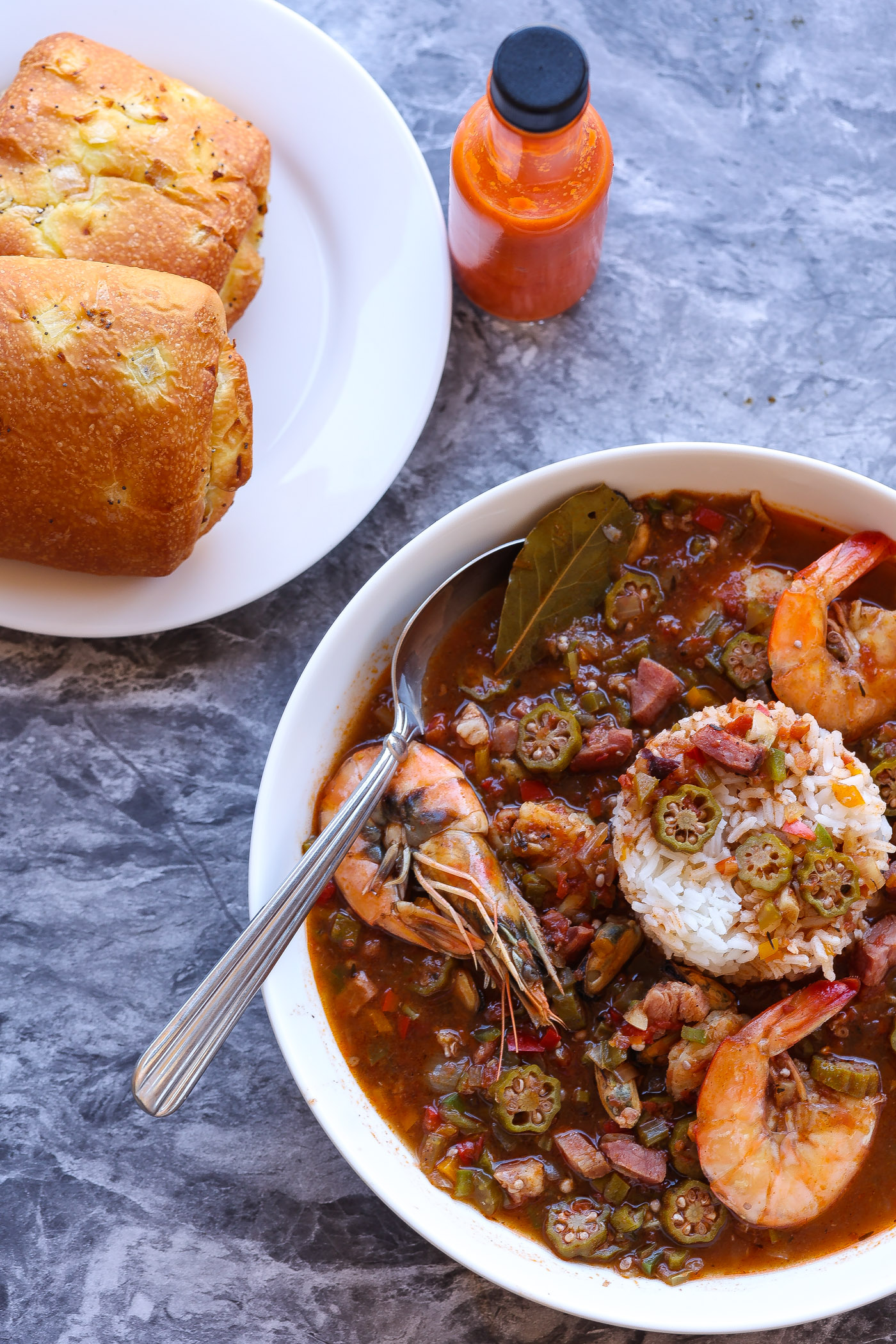
Connection to West African Okra Soup
Okro soup is one such dish that birth many other derivative recipes across the diaspora from gumbo to callaloo and several dishes in between. It is a savory main dish that combines okra, meat, fish, and spices cooked in palm oil. It has traveled with our ancestors from Nigeria to be adopted in South America and the American South.
Today, I’m teaching you how to make Okra Gumbo from the Deep South - Louisiana and encourage you to follow the story through Caruru Baiano from the Bahaian region of Brazil and its origin recipe, Okra Soup from Nigeria.
Share these recipes with your friends and loved ones and follow each participant by using the hashtag #BHMVP2023 on Instagram. You can grab the full list of recipes from this year’s collaboration on the Eat The Culture website.
When I think of gumbo, I think of a lot of ingredients being slowly simmered in a big pot and coming together to create that magical dish where all those ingredients somehow blend together perfectly. More importantly, if you break down gumbo to its essence, then you begin to understand a lot about Southern foodways.
Gumbo in its most popular form is simply fusion food representing influences of Africans first and foremost as well as Native Americans and Europeans. Colonization in all its glory is the vessel responsible for all of this.
Beats and Eats (music to pair with Okra Gumbo)
Yo, "Free" by Goodie Mob, meet Okra Gumbo and Shrimp, a match made in Southern heaven. Just like Cee-Lo and the Mob spit truth in their verses, this dish brings the heat, freedom, and flavor to the table.
Picture the lyrics painting a picture of liberation, struggle, and victory, while that gumbo simmers to perfection, allowing the spices to liberate those taste buds, the okra to dance freely, and the shrimp to bring that savory punch.
It's a harmony of taste and truth, a culinary anthem for the soul, setting you free with every bite and every beat. Let the music vibe and the flavors flow, a true Southern fusion. Peace, love, and gumbo on!
When you understand the story of how okra made it from Africa to the Americas you begin to see and comprehend how resilient a people black folks are. Under the worst conditions and situations, black people have risen above and produced sustenance, beauty, and excellence. Though prisoners of an unjust system black folks continue to fight for not only their freedom but also for the freedom of others.
What is Gumbo?
In its most basic form, gumbo is simply a stew that brings together a bunch of different ingredients including vegetables, a variety of meats, herbs, and a stock whether chicken broth, seafood stock, or vegetable stock. Thickening agents, or not, are used to create the desired consistency of the cook.
Gumbo has become synonymous with Louisiana cooking particularly European cajun. However, this denies and whitewashes the history of this glorious stew that has its origins in Mother Africa.
The reality is the popular current form, with the exception of the roux, is a derivative of West Africa's okra soup which predates the Atlantic slave trade. Okra soup's core ingredients were/are okra and tomatoes stewed slowly likely with chicken or shellfish.
What is the History of Gumbo?
In West Africa where okra soup originated and became popular, the word for okra is ki ngombo which often is shortened and written or spoken as gombo. Okra was used as the primary thickener in the dish which looks very familiar with Louisiana gumbo.
The use of sassafras (leaves ground down to create filé powder) was a Native American contribution and the use of a roux we owe to the French. Both are thickening agents which adds to the many different variations of gumbo in the region and beyond. The popularity of roux-based gumbos has led to the iconic status of this style of gumbo which has also contributed to the appropriation of African gumbo.
Importance of Okra
Okra is a plant believed to have originated in Africa eventually making its way to West Africa where it has been cultivated for thousands of years. It was one of a few key crops that was brought to the Americas by enslaved Africans and has since become a staple in Southern cuisine.
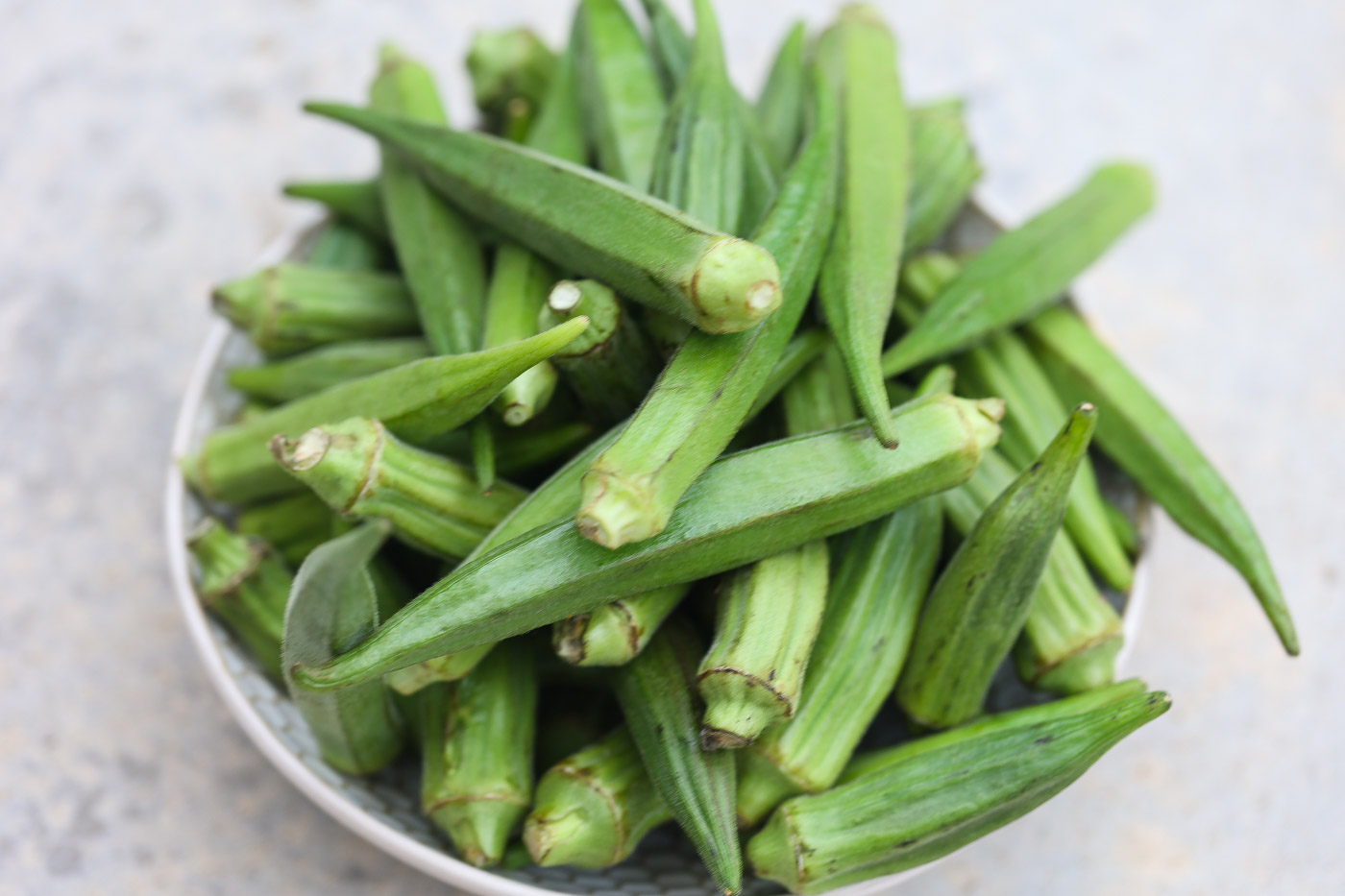
Variations of Gumbo
Okra gumbo is a popular version of gumbo that uses okra as a thickener. Some variations of okra gumbo include:
- Seafood gumbo: Made with seafood such as shrimp, crab, and/or oysters.
- Chicken and Andouille sausage gumbo: Made with chicken, chicken broth, and spicy Andouille sausage.
- Vegetarian gumbo: Made without meat or seafood, using plant-based ingredients such as mushrooms, eggplant, or tofu.
- Duck gumbo: Made with duck meat.
- Turkey gumbo: Made with leftover turkey meat.
- Sausage and ham gumbo: Made with various types of sausage and ham.
- Gumbo Z'herbes: Made with mix of greens, herbs, cajun seasoning, and meat like turkey or sausage.
These are just a few variations, and the ingredients and flavors of gumbo can be adjusted to suit individual tastes and dietary restrictions.
Ingredients needed to make shrimp and okra gumbo
For The Stock
- Shrimp shells and heads - these will be blended with water which captures much more flavor than simply boiling the shells.
- Carrots
- Celery
- Yellow Onion
- Water
- Dry White Wine - cheap chardonnay or sauvignon blanc
- Peppercorns
- Kosher Salt
- Dried Shimp - African cooking involves seasoning recipes with dried seafood, especially in soups and stews. It adds a distinct "umami" rich type flavor. Dried shrimp can be found in Asian markets as well as those that cater to Caribbean/African shoppers.
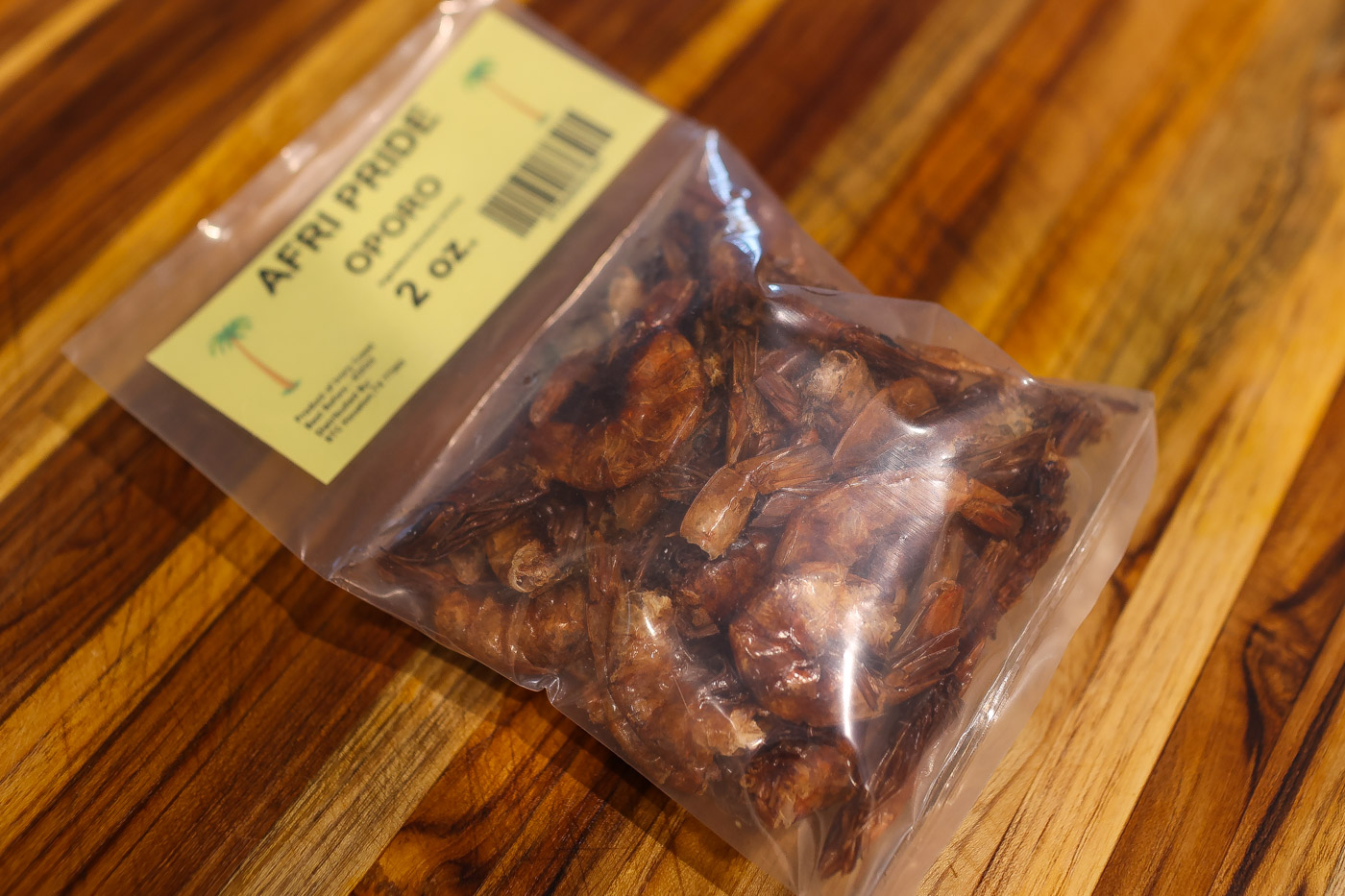
For The Spice Mix
- Smoked Paprika
- Cayenne pepper
- Garlic Powder
- Onion Powder
- Dried Thyme
- Kosher Salt
- Black Pepper
For The Gumbo
- Olive oil or Vegetable Oil
- Fresh okra (sliced thin)
- Shrimp
- Mussels meat
- Smoked Ham
- Onions
- Bell pepper (multi-color), finely chopped
- Celery
- Bay leaf
- Fresh Thyme
- Crushed Tomatoes
- Gumbo File powder
- Fresh chopped parsley (for garnishing)
- Fresh green onions (for garnishing)
How to Make Okra Gumbo - the Recipe Method
Make the spice mix
Add all the ingredients to a small mixing bowl or ramekin. Mix well and set aside.
Make the shrimp stock
Wash the whole shrimp in your sink. Peel the shrimp fully removing the heads, tails, and shells.
Set the shrimp aside and place the shells, tails, and heads in a blender or food processor.
Add about a quart and a half of water to the blender and puree fully.
Place the stock base to a large stock pot and add the garlic cloves, carrots, celery, onions, dried shrimp, peppercorns, and salt. Bring to a boil then reduce heat to a simmer. Simmer for an hour and set aside. Store in the refrigerator.
Make the Gumbo
Heat a large dutch oven pot on medium-high heat. Add the oil and then saute the onions, peppers, garlic, and celery for 3-4 minutes. Add a quarter of the dry seasoning mix to the vegetables for the last minute of cooking.
Add the sliced okra, more of the seasoning mix, crushed tomatoes, and gumbo filé powder. Mix well and cook for another 3-4 minutes stirring frequently.
Add the bay leaves, plus 4 cups of the shrimp stock, and the rest of the seasoning mix and mix well with a wooden spoon. Cover and cook on low for 30 minutes.
Add shrimp, mussels, and ham to the pot. Mix well and cook another 5 minutes. Turn off heat, discard bay leaves, and set aside.
Serve the gumbo over a bowl of cooked rice. Top with chopped fresh parsley and diced green onions with your favorite hot sauce.
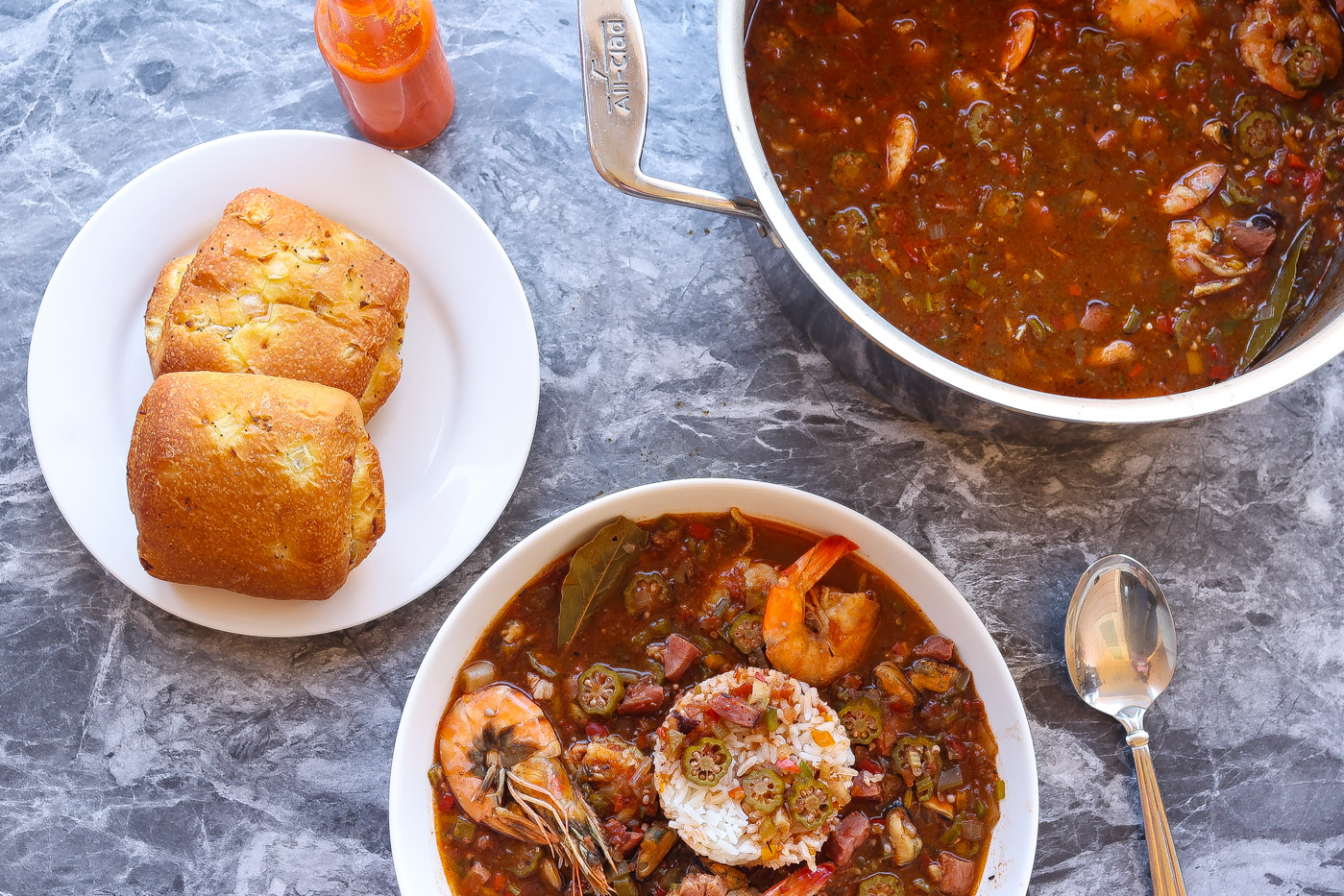
Best Sausage For Gumbo
The best sausage for gumbo is typically a flavorful and robust sausage that can stand up to the bold flavors of the dish. Andouille sausage is the most traditional and popular choice for gumbo. Here's why:
- Flavor and Spice:
- Andouille sausage is known for its strong, smoky flavor and spicy kick, which adds depth and complexity to the gumbo.
- Cajun Cuisine Authenticity:
- Andouille sausage is a staple in Cajun and Creole cooking, which are the cuisines that gumbo originates from. Using Andouille keeps the dish true to its roots.
- Texture and Fat Content:
- Andouille sausage has a coarse texture and a good amount of fat, which adds moisture and richness to the gumbo.
- Stands Up to Cooking:
- Andouille sausage holds up well to the long cooking process of gumbo, allowing its flavors to meld into the dish without losing its own distinct taste.
However, if Andouille sausage is not available or you're looking for alternatives, other sausages like smoked sausage, kielbasa, chorizo, or hot Italian sausage can also work. Choose a sausage that has a good balance of flavors and spiciness, ensuring it complements the overall taste of the gumbo.
Tips, Substitutions, and Other Considerations For This Gumbo Recipe
Tips for Flavorful Gumbo
- Use a flavorful stock: The stock is boss when it comes to flavoring a large pot of gumbo. Invest the time in making the shrimp stock as it adds flavor you wouldn't believe.
- Make a flavorful roux: I made this okra gumbo without a roux to stay closer to the African way of making gumbo, but I have nothing against a good roux. I typically use them in my gumbos for added flavor and consistency. Just be prepared to be stirring constantly for a nice rich roux.
- Use high-quality ingredients: Choose the best seafood, meat, and vegetables you can find to enhance the flavor of the gumbo.
- Add the okra carefully: Okra can become slimy if overcooked, so it's best to add it towards the end of the cooking process.
- Be patient: Gumbo takes time to cook, and the flavors develop as it simmers. Don't rush the process by increasing the heat.
- Season to taste: Taste the gumbo as you cook and adjust the seasoning to your preference. Remember that salt can be added at the end of cooking, but it's difficult to remove if it's added too early.
- Brown or roast the okra first: Start by browning the okra in butter or oil before adding it to the pot. This will boost the okra flavor and ensure the okra won't become slimy when it cooks down.
- Add aromatic fresh herbs: Crushed bay leaves and fresh thyme (lots of it) will give your gumbo a complex yet subtle taste that pairs nicely with okra.
Substitutions
Here are some common substitutions you can make when cooking okra gumbo:
- Roux: If you plan to use a roux but don't have time to make one from scratch, you can use a store-bought roux mix or a combination of starch and oil.
- Okra: If you can't find fresh okra, frozen okra can be used instead. Alternatively, you can use another thickener, such as file powder (dried sassafras leaves), or a small amount of cornstarch mixed with water.
- Meat: I used smoked ham that I diced up. Smoked turkey or andouille sausage are good substitutes for the ham.
- Seafood: If you don't have access to fresh seafood, you can use canned or frozen seafood. I bought frozen mussels meat, but could have used packed oyster meat. Frozen crawfish tails are also good options.
- Vegetables: Most gumbo recipes call for green bell pepper. This makes sense, but to add a bit more color and pizzaz to the dish add a mix of different color bell peppers like red, yellow, or orange.
- Creole seasoning: I prefer to make my own creole seasoning mix for more flavor and less salt. There are certainly many different store-bought options should you go that route and have a favorite.
- Stock: This homemade seafood stock is delicious and highly reommended as it's what gives this gumbo it's unique character and flavor. You can swap for chicken stock or a commercial seafood stock if in a pinch.
- Tomatoes: I used crushed tomatoes, but canned tomatoes liked diced tomatoes could work well.
Remember that substitutions can change the flavor and texture of the gumbo, so be prepared to adjust the seasonings and cooking time as needed.
Other Considerations
- Serve with rice: Gumbo is traditionally served over a bed of rice, which helps to soak up the flavorful broth. In certain areas of the South people serve potato salad with their gumbo.
- Store leftovers properly: Gumbo is best enjoyed fresh, but leftovers can be stored in the refrigerator for up to three days. Reheat gently to preserve the flavors and texture.
- Tomatoes are a good thing: Use tomato paste or crushed tomatoes for more flavor complexity. Whether tomatoes belong in gumbo or not is a big debate among the gumbo "experts." In my book the ancestors have shown how well okra and tomatoes work together. Include tomatoes! You'll get no judgment here.
- Be easy with the heat levels: Gumbo doesn't have to be overly hot. I rely solely on the cayenne pepper for heat and then allow people to add any additional heat with either hot sauce or crushed red pepper if more heat is needed.
Frequently Asked Questions (FAQs) About Making Okra Gumbo
Roux or No Roux?
Roux is a European-added element to gumbo and is commonly used to thicken and flavor gumbo recipes. The roux is the base of the gumbo and if using in a recipe it should be cooked long enough to develop a deep, nutty flavor. Roux requires constant stirring unless you take my favorite shortcut of making an oven-based roux.
What is filé powder?
Filé powder is a seasoning made from ground sassafras leaves, commonly used in Creole cuisine, especially in gumbo. It is sprinkled on top of gumbo just before serving, and provides a unique flavor and thickening property. The powder helps thicken the stew-like gumbo, and imparts a slightly bitter and earthy flavor.
What is the difference between gumbo and jambalaya?
Jambalaya is a rice-based dish that also includes meat and vegetables, while gumbo is a soup or stew-like dish that is served over rice. Gumbo has a thicker consistency, due to the roux used in the base, while jambalaya is more like a moist rice dish.
Is gumbo spicy?
Gumbo can be made to be spicy or mild, depending on personal preference and the amount of cayenne pepper used.
What does okra do to gumbo?
Okra is commonly used as a thickener in gumbo. It also adds a slightly vegetal flavor and a unique texture to the dish.
How do you make okra not slimy in gumbo?
- The smaller the okra pods, the less slime you’ll get
- Wash and dry okra very thoroughly. Drying is key!
- Generally speaking, cook okra at high heat levels quickly using methods like roasting, searing, frying, or grilling.
- Make sure your cast iron skillet, grill, or fryer are hot before you start cooking okra. Shoot for a good external sear/char that has the added benefit of nuking the slime
- Cook okra in small batches. Overcrowded pans bring temps down which leads to steam which leads to slime
- Acid is the anti slime. Viner, lemon juice, wine, or canned tomato juice will add flavor plus slime control
- Add okra at the very end when you’re ready to eat the dish as this will minimize contact with moisture.
Should okra be cooked before adding to gumbo?
It doesn't have to be. Adding fresh or frozen to gumbo works just fine. However, you can level things up a bit by roasting the okra first.
What is the secret to good gumbo?
There are a few critical things you need to make the best gumbo. I focus on making a good quality stock to get more flavor bang for your buck.
Does authentic gumbo have okra?
Yes, authentic gumbo typically includes okra as a thickener. However, not all gumbo recipes use okra, and some traditional gumbo recipes use other thickeners, such as a roux, filé powder, or corn starch slurry. The ingredients and methods used to make gumbo can vary depending on regional and personal preferences.
When should you add okra to gumbo?
Okra is typically added to gumbo during the later stages of cooking, usually 20-30 minutes before the end of the cooking time. This allows the okra to cook through and thicken the stew, while minimizing the sliminess that can result from overcooking. Adding the okra too early can result in a slimier texture, while adding it too late may not allow it to fully cook and thicken the gumbo.
How do you cut okra for gumbo?
For gumbo, okra is usually cut into rounds or small pieces, about ¼-1/2 inch in size. To cut the okra, first wash and dry the pods, then trim the stem end and slice the pods crosswise into rounds or chop them into small pieces as desired.
Cutting the okra into smaller pieces will result in more surface area being exposed, which can make the stew thicker and potentially slimier. Larger pieces may provide a slightly firmer texture.
Make This Recipe
This okra gumbo recipe is the perfect comfort food for gumbo season. It's packed with flavor and has just the right amount of spice. Shrimp and okra are the stars of this dish, but they wouldn't be nearly as successful without the supporting cast of flavorful vegetables, aromatic spices, and a delicious shrimp stock.
So if you're looking for a new gumbo recipe to try, give this one a go. You won't be disappointed.
If you make this delicious okra gumbo recipe or any other from the site, please come back and leave me a comment below with your feedback. Definitely take a photo of the dish and be sure to tag #foodfidelity so that I can see them.
You can also keep up with my food exploits as well as original recipes! You can find me on Instagram, Facebook, Twitter, and Pinterest. If you like any of the music you find on the site, visit me at Spotify to find curated monthly playlists.
Lastly, go to my YouTube channel and subscribe to be notified when new weekly videos are uploaded.
Ingredients
For the Creole Spice Seasoning
- ½ teaspoon cayenne pepper
- 1 teaspoon smoked paprika
- ½ teaspoon garlic powder
- ½ teaspoon onion powder
- ½ teaspoon dried thyme thyme
- 1 teaspoon kosher salt
- 1 teaspoon black pepper
For the Shrimp Stock
- 2 cups shrimp shells heads, and tails
- 3 celery ribs chopped roughly
- 1 large onion cut into large pieces
- 4 garlic cloves peeled and smashed
- 2 medium carrots
- ½ cup dried smoked shrimp
- 8-10 black peppercorns
- 1 tablespoon kosher salt
- 1 ½ quarts water
For the Gumbo
- 1 tablespoon vegetable oil
- 3 pounds fresh okra sliced thin
- 1 yellow onion diced
- 1 green bell pepper diced
- 2 celery ribs diced
- 14 oz canned crush tomatoes
- 4 cups shrimp stock
- 1 pound shrimp cleaned and deveined
- ½ pound smoked ham diced
- 1 cup mussels meat
- 2 bay leaves
Instructions
Make the spice mix
- Add all the ingredients to a small mixing bowl or ramekin. Mix well and set aside.
Make the shrimp stock
- Wash the whole shrimps in your sink. Peel the shrimp fully removing the heads, tails, and shells.
- Set the shrimp aside and place the shells, tails, and heads in a blender or food processor.
- Add about a quart and a half of water to the blender and puree fully.
- Place the stock base to a large stock pot and add the garlic cloves, carrots, celery, onions, dried shrimp, peppercorns, and salt. Bring to a boil then reduce heat to a simmer. Simmer for an hour and set aside. Store in the refrigerator.
Make the Gumbo
- Heat a large dutch oven pot on medium heat. Add the oil and then saute the onions, peppers, garlic, and celery for 3-4 minutes. Add a quarter of the dry seasoning mix to the vegetables for the last minute of cooking.
- Add the sliced okra, more of the seasoning mix, crushed tomatoes, and gumbo filé powder. Mix well and cook for another 3-4 minutes stirring frequently.
- Add the bay leaves, plus 4 cups of the shrimp stock, and the rest of the seasoning mix. Cover and cook on low for 30 minutes.
- Add shrimp, mussels, and ham to the pot. Mix well and cook another 5 minutes. Turn off heat and set aside.
- Serve the gumbo over a bowl of cooked rice. Top with chopped fresh parsley and diced green onions with your favorite hot sauce.
Video

Notes
Tips for Flavorful Gumbo
- Use a flavorful stock: The stock is boss when it comes to flavoring a large pot of gumbo. Invest the time in making the shrimp stock as it adds flavor you wouldn't believe.
- Make a flavorful roux: I made this okra gumbo without a roux to stay closer to the African way of making gumbo, but I have nothing against a good roux. I typically use them in my gumbos for added flavor and consistency. Just be prepared to be stirring constantly for a nice rich roux.
- Use high-quality ingredients: Choose the best seafood, meat, and vegetables you can find to enhance the flavor of the gumbo.
- Add the okra carefully: Okra can become slimy if overcooked, so it's best to add it towards the end of the cooking process.
- Be patient: Gumbo takes time to cook, and the flavors develop as it simmers. Don't rush the process by increasing the heat.
- Season to taste: Taste the gumbo as you cook and adjust the seasoning to your preference. Remember that salt can be added at the end of cooking, but it's difficult to remove if it's added too early.
- Brown or roast the okra first: Start by browning the okra in butter or oil before adding it to the pot. This will boost the okra flavor and ensure the okra won't become slimy when it cooks down.
- Add aromatic fresh herbs: Crushed bay leaves and fresh thyme (lots of it) will give your gumbo a complex yet subtle taste that pairs nicely with okra.

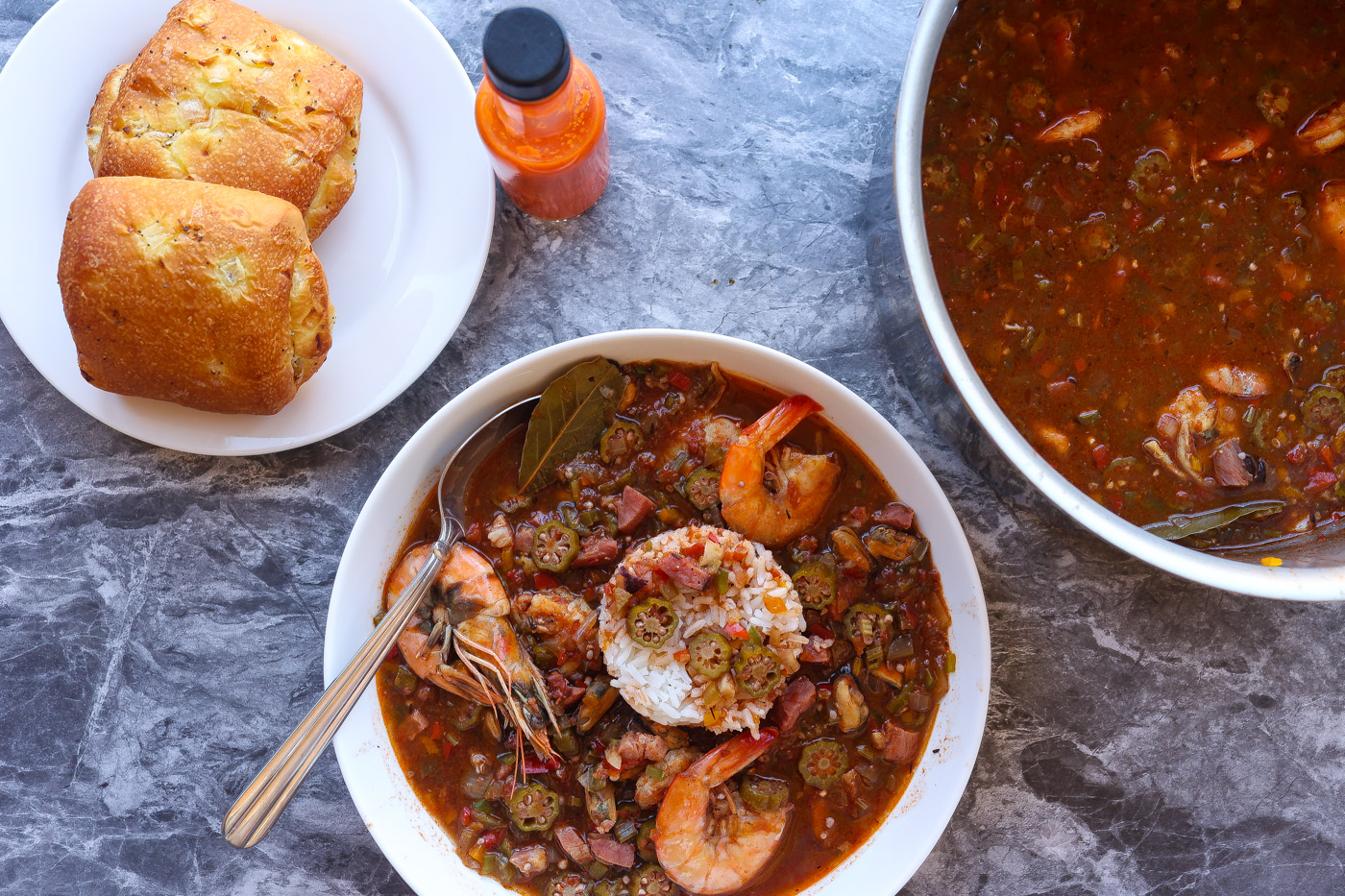
JoeW
Tuesday 19th of September 2023
Sir, if you will pardon a newbi question: Does the shrimp stock need to be strained/filtered before use?
Many thanks, Joe
Marwin Brown
Wednesday 20th of September 2023
Great question! It's a personal preference thing I default to straining it myself just in case you miss blending fully, but growing up my folks didn't.
Marie
Friday 3rd of February 2023
I like that this recipe made its way around the globe! I'm not too familiar with Gumbo nor okra but now I feel I know much more! I'm definitely going to try it out!